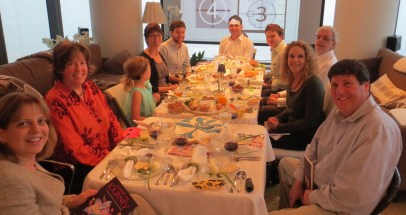I know, I know, Purim hasn’t even arrived yet, but Passover isn’t too far away and it’s never too early to begin to think about preparations. One of the first questions that always comes up is which haggadah to use. Here at the CCAR, we have a long history of publishing haggadot, and today we offer many different options. Each one offers something a little bit different to meet the needs of your family or community.
It all began in 1892, which marks the beginning of Reform haggadot in North America. That was when the CCAR attempted to publish the first Union Prayer Book, in which a new haggadah was meant to be incorporated. That prayer book was ultimately and infamously rejected by the CCAR, and the haggadah was later published as a stand-alone volume (the subsequent UPB 2, which did pass the approval process, did not include the haggadah).
This early haggadah was an adaptation by Rabbi Isaac Moses of an even earlier Reform haggadah published in Bavaria in German by Rabbi Leopold Stein in 1841. This original haggadah, as well as its subsequent adaptations and translations, was a contemporary rethinking of Passover for the Jews of the time. As Dr. Richard Sarason writes, “While a strong affective connection to the seder ritual remains, there is a clear cognitive distancing from its premodern form and some of its content, which is either eliminated entirely or reshaped to conform to contemporary sensibilities. The passages of classical Rabbinic discourse are deleted, as are any angry or vengeful references to the gentiles” (Sarason, “The Haggadah and Reform Judaism” in The New Union Haggadah, CCAR Press, 2014). Redemption is framed not as something far off in the future to which to yearn, but rather taking place in its audience’s own time as Jews gained political, social, and professional rights. A revision, with slightly more Hebrew, was published in 1907/08.
 The beloved gray hardcover known as the Union Haggadah, published in 1923, was a revision of this early 19th century haggadah (the image here is of the paperback facsimile version). This edition contains more Hebrew than the earlier versions, had a fuller version of the Exodus story, and also restored the traditional divisions of the seder. But it still shared the original sensibility, looking not toward a future time of redemption but celebrating the freedom and liberty available to Jews in North America. Generations of Reform Jews were raised on this version of the haggadah, as well as the revised version published following World War II. It was also appreciated for its gorgeous black and white artwork and elegant design, as well as the musical notation provided. The CCAR Press has made a paperback version of this haggadah available.
The beloved gray hardcover known as the Union Haggadah, published in 1923, was a revision of this early 19th century haggadah (the image here is of the paperback facsimile version). This edition contains more Hebrew than the earlier versions, had a fuller version of the Exodus story, and also restored the traditional divisions of the seder. But it still shared the original sensibility, looking not toward a future time of redemption but celebrating the freedom and liberty available to Jews in North America. Generations of Reform Jews were raised on this version of the haggadah, as well as the revised version published following World War II. It was also appreciated for its gorgeous black and white artwork and elegant design, as well as the musical notation provided. The CCAR Press has made a paperback version of this haggadah available.
 In 1974 CCAR published A Passsover Haggadah, known familiarly as “the Baskin” though it should be known as the Bronstein-Baskin, created as it was under the editorial leadership of Rabbi Herbert Bronstein. This was the first full color haggadah from the Reform Movement, incorporating the striking art of Leonard Baskin. A Passover Haggadah became an instant bestseller, as ubiquitous in Reform homes as The Union Haggadah once was. This haggadah incorporates many supplementary readings and songs, drawing on the post-Holocaust Jewish experience as well as acknowledging the existence of and relationship with Israel. It uses a much fuller Hebrew text than the previous haggadot, a beautiful poetic style of English, adds back in much of the rabbinic commentary edited out in various editions of The Union Haggadah, and draws on many contemporary sources including Hebrew poetry. This is an excellent haggadah for those who want a rich seder experience, with a tremendous amount of material to build upon.
In 1974 CCAR published A Passsover Haggadah, known familiarly as “the Baskin” though it should be known as the Bronstein-Baskin, created as it was under the editorial leadership of Rabbi Herbert Bronstein. This was the first full color haggadah from the Reform Movement, incorporating the striking art of Leonard Baskin. A Passover Haggadah became an instant bestseller, as ubiquitous in Reform homes as The Union Haggadah once was. This haggadah incorporates many supplementary readings and songs, drawing on the post-Holocaust Jewish experience as well as acknowledging the existence of and relationship with Israel. It uses a much fuller Hebrew text than the previous haggadot, a beautiful poetic style of English, adds back in much of the rabbinic commentary edited out in various editions of The Union Haggadah, and draws on many contemporary sources including Hebrew poetry. This is an excellent haggadah for those who want a rich seder experience, with a tremendous amount of material to build upon.
 The Open Door, edited by Rabbi Sue Levi Elwell and published in 2002, reflects further changes in the North American Jewish community. This haggadah, with beautiful art by Ruth Weisberg, incorporates voices of those previously marginalized or left out, including women’s voice, GLBT voices, and those from non-Ashkenazi Jewish communities. This haggadah is a great addition to any collection, offering new perspectives on familiar texts and opening the door for all those who want to enter.
The Open Door, edited by Rabbi Sue Levi Elwell and published in 2002, reflects further changes in the North American Jewish community. This haggadah, with beautiful art by Ruth Weisberg, incorporates voices of those previously marginalized or left out, including women’s voice, GLBT voices, and those from non-Ashkenazi Jewish communities. This haggadah is a great addition to any collection, offering new perspectives on familiar texts and opening the door for all those who want to enter.
 In 2012 CCAR Press added another haggadah to our offerings. Sharing the Journey: The Haggadah for the Contemporary Family, edited by Alan Yoffie with gorgeous full color artwork by Mark Podwal, offers a welcoming and accessible approach to Passover. This haggadah is especially a good fit for those who don’t know a lot about Passover rituals or practices but wants to get started, or those with non-Jewish family members and friends around the table. All are warmly welcomed and included in the shared experience of moving from slavery to redemption, with Sharing the Journey follows the traditional steps of the seder in a joyous, streamlined, non-intimidating way. All Hebrew is fully transliterated and gender inclusive. There are discussion questions and explanations throughout. This Haggadah is also a great choice for congregational seders, which could be accompanied by the forthcoming Visual T’filah version. A separate Leader’s Guide is available, including a 2 CD set, and the album is also available on iTunes, both with words and without, for singing along too. There is also an iPad version of Sharing the Journey, and it will shortly be available as Visual T’filah, a terrific resource for congregational seders. In addition, a selection of Podwal’s signed giclee prints of images from the book are available and make special very special gifts.
In 2012 CCAR Press added another haggadah to our offerings. Sharing the Journey: The Haggadah for the Contemporary Family, edited by Alan Yoffie with gorgeous full color artwork by Mark Podwal, offers a welcoming and accessible approach to Passover. This haggadah is especially a good fit for those who don’t know a lot about Passover rituals or practices but wants to get started, or those with non-Jewish family members and friends around the table. All are warmly welcomed and included in the shared experience of moving from slavery to redemption, with Sharing the Journey follows the traditional steps of the seder in a joyous, streamlined, non-intimidating way. All Hebrew is fully transliterated and gender inclusive. There are discussion questions and explanations throughout. This Haggadah is also a great choice for congregational seders, which could be accompanied by the forthcoming Visual T’filah version. A separate Leader’s Guide is available, including a 2 CD set, and the album is also available on iTunes, both with words and without, for singing along too. There is also an iPad version of Sharing the Journey, and it will shortly be available as Visual T’filah, a terrific resource for congregational seders. In addition, a selection of Podwal’s signed giclee prints of images from the book are available and make special very special gifts.
 Our latest haggadah is a completely revised edition of the 1923 Union Haggadah. This edition, The New Union Haggadah, is being created in consultation with the Society for Classical Reform Judaism, with Rabbi Howard Berman as consulting editor and Rabbi Ben Zeidman as development editor. This revision features beautiful updates of the original artwork, as well as some new full color art based on Passover images from stained glasses windows found in Reform synagogues across North America. For those who still feel connected to the 1923 edition but want something slightly more contemporary, this is a perfect choice. This edition preserves the beauty and elegance of the original, with its focus on the shared Jewish and American moral values and emphasis on liberty for all, while now offering full transliteration, gender inclusive language, and updates to the original such as Miriam’s cup and the option of an orange on the seder plate. In addition, we are also offering a large print edition.
Our latest haggadah is a completely revised edition of the 1923 Union Haggadah. This edition, The New Union Haggadah, is being created in consultation with the Society for Classical Reform Judaism, with Rabbi Howard Berman as consulting editor and Rabbi Ben Zeidman as development editor. This revision features beautiful updates of the original artwork, as well as some new full color art based on Passover images from stained glasses windows found in Reform synagogues across North America. For those who still feel connected to the 1923 edition but want something slightly more contemporary, this is a perfect choice. This edition preserves the beauty and elegance of the original, with its focus on the shared Jewish and American moral values and emphasis on liberty for all, while now offering full transliteration, gender inclusive language, and updates to the original such as Miriam’s cup and the option of an orange on the seder plate. In addition, we are also offering a large print edition.
 And then there’s A Children’s Haggadah, by Howard Bogot and Robert Orkand, with illustrations by Devis Grebu. This child-friendly haggadah features a vibrant fold-out section of the whole seder plate. Designed especially for young people, this haggadah is a great choice for home seders with lots of young children, as well as for schools or community family seders.
And then there’s A Children’s Haggadah, by Howard Bogot and Robert Orkand, with illustrations by Devis Grebu. This child-friendly haggadah features a vibrant fold-out section of the whole seder plate. Designed especially for young people, this haggadah is a great choice for home seders with lots of young children, as well as for schools or community family seders.
There are many haggadot to choose from. We’re proud to be able to offer a range of different options. And of course there’s always the tradition of collecting many different haggadot, all the better to pick and choose the parts you like from each. Have fun making your choice, and chag sameach!
Rabbi Hara Person is the Publisher and Director of CCAR Press.
 We also realized that our Seder needed a Haggadah that was filled rich and varied readings, colorful interpretations, easily accessible instructions, and enticing visualization from which we could sample. We have become enamored with Sharing the Journey: The Haggadah for the Contemporary Family (written by Alan S. Yoffie, illustrations by Mark Podwal) published by the CCAR Press. This rabbi-approved Haggadah is as accessible and creative as our personally cut-and-pasted booklets of our younger years with a few fantastic differences: Adults and children alike always seem to discover age appropriate material that uplifts and inspires. Teens and college students appreciate its ability to challenge contemporary understandings, while the grandparents like that it has enough traditionalism to recall their Seders of old. We like the fact that we can use it both at one night’s creative and another evening’s more traditional sit down Seder.
We also realized that our Seder needed a Haggadah that was filled rich and varied readings, colorful interpretations, easily accessible instructions, and enticing visualization from which we could sample. We have become enamored with Sharing the Journey: The Haggadah for the Contemporary Family (written by Alan S. Yoffie, illustrations by Mark Podwal) published by the CCAR Press. This rabbi-approved Haggadah is as accessible and creative as our personally cut-and-pasted booklets of our younger years with a few fantastic differences: Adults and children alike always seem to discover age appropriate material that uplifts and inspires. Teens and college students appreciate its ability to challenge contemporary understandings, while the grandparents like that it has enough traditionalism to recall their Seders of old. We like the fact that we can use it both at one night’s creative and another evening’s more traditional sit down Seder.
























